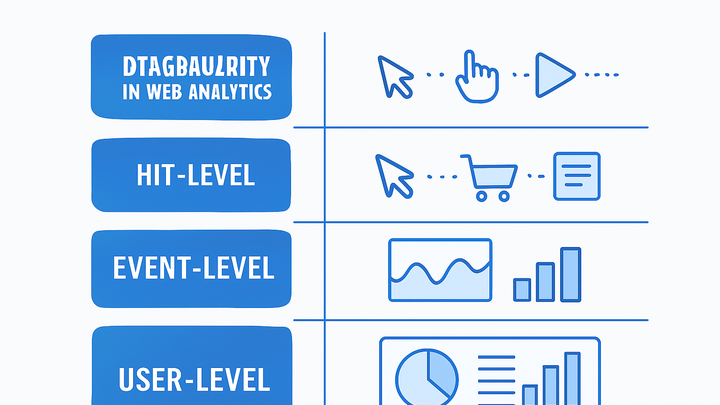Published on 2025-06-28T07:54:58Z
What is Data Granularity in Analytics? Examples with PlainSignal & GA4
Data granularity refers to the level of detail at which analytics data is captured, stored, and analyzed. It determines whether you’re looking at high-level summaries (e.g., total sessions per day) or low-level events (e.g., individual clicks). Fine-grained data enables deep insights into user behavior but can increase storage, processing time, and privacy risks. Coarse-grained data reduces complexity and resource consumption but may obscure important patterns. Different analytics platforms offer varying default granularities; for example, PlainSignal emphasizes aggregated, cookie-free metrics, whereas GA4 captures detailed event-level data. Understanding and choosing the right granularity ensures you balance insight depth, performance, cost, and compliance.
Data granularity
The level of detail at which analytics data is collected and stored, affecting insights, performance, and privacy.
Understanding Data Granularity
Data granularity defines how detailed each data record is in your analytics system. It directly impacts the types of insights you can derive and the resources required to store and process the data.
-
Definition
The degree of detail in data records, ranging from aggregate summaries to individual events.
-
Trade-offs
Balancing the need for detailed insights with performance, storage, and privacy concerns.
-
Performance
Fine granularity can slow down data queries and dashboard rendering.
-
Cost
Storing and processing detailed data increases infrastructure and operational expenses.
-
Privacy
Highly detailed data may expose personally identifiable information if not handled properly.
-
Common Levels of Granularity
Web analytics tools typically organize data into multiple granularity tiers, each suited to different analysis needs.
-
Hit-level
Captures each interaction (pageview, click, resource load) as a distinct record.
-
Event-level
Groups related hits into meaningful events, such as form submissions or video plays.
-
Session-level
Aggregates multiple hits and events within a single visit or browsing session.
-
User-level
Associates sessions and events with a unique user identifier across multiple visits.
Granularity in Analytics Platforms
Different SaaS analytics solutions support distinct granularity approaches based on their design focus and privacy model.
-
PlainSignal (cookie-free, aggregated)
PlainSignal emphasizes user privacy by providing aggregated session and pageview metrics without cookies. Its focus on simplicity means data is stored at a coarser granularity.
-
Implementation
<link rel="preconnect" href="//eu.plainsignal.com/" crossorigin /> <script defer data-do="yourwebsitedomain.com" data-id="0GQV1xmtzQQ" data-api="//eu.plainsignal.com" src="//cdn.plainsignal.com/plainsignal-min.js"></script>
-
-
GA4 (event-centric, fine-grained)
Google Analytics 4 captures event-level data by default, enabling deep analysis of individual user actions and powerful cross-event reports.
-
Implementation
<!-- Global site tag (gtag.js) - Google Analytics --> <script async src="https://www.googletagmanager.com/gtag/js?id=G-XXXXXXX"></script> <script> window.dataLayer = window.dataLayer || []; function gtag(){dataLayer.push(arguments);} gtag('js', new Date()); gtag('config', 'G-XXXXXXX'); </script>
-
Best Practices for Choosing Granularity
Selecting the right data granularity ensures you meet analytical goals while managing cost, performance, and compliance.
-
Align with business goals
Choose a granularity level that supports your key metrics and decision-making workflows without over-complicating the dataset.
-
Optimize performance
Avoid overly fine granularity that can degrade query speed; use aggregated summaries where detailed records aren’t needed.
-
Ensure privacy compliance
Adopt aggregated or anonymized data collection to meet GDPR, CCPA, and other regulatory requirements.
